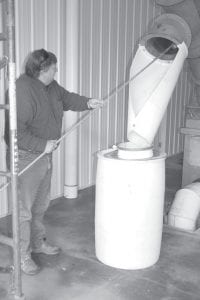On September 22, 2010, Grand Marais Water/ Wastewater Superintendent Tom Nelson showed Public Utilities Commissioners the septic treatment plant built in Cedar Grove Business Park by Pete Gresczyk of G & G Septic Service. Septic waste is pumped from trucks into a processor where the septage is cleaned and sprayed and solids are separated from liquids. The resulting solids are fairly dry and do not smell bad or attract bugs, even in the summer, Nelson said. They are put into mesh bags that look similar to potato sacks and transported to a facility in Duluth. According to Nelson, solids from a truckload of septage don’t even fill up one bag. The liquids go into the city’s sewer treatment system under the ground. Processing the septage takes only 20-30 minutes. This facility will eliminate the county’s need for open septic dumping fields, which have been in short supply because of the terrain in Cook County. It will also eliminate a majority of the trips G & G Septic had been taking to dispose of septage in Duluth since the county has not had the needed septic fields in the last seven or eight years. “The standards are getting higher,” Nelson said. He told commissioners that leachate from the Taconite Harbor mining facility is discharged here and cleans out the underground tanks. Gresczyk pays more for what he sends into the city sewer system than city homeowners do because it is denser than what comes from houses. “Everybody won in this deal,” PUC Commission Hal Greenwood said. Right: Tom Nelson pulls treated solids into a transport bag.

With the Grand Marais Wastewater Treatment Plant’s current National Pollutant Discharge Elimination System/State Disposal System permit ready to expire at the end of next March, the Minnesota Pollution Control Agency (MPCA) is holding a public comment period from September 22 to October 22, 2010.
The MPCA commissioner has made a preliminary determination to reissue the permit for approximately another five years.
Citizens have the right to submit written comments, petition for a public informational meeting or a contested case hearing, or request that the MPCA Citizens’ Board consider the issuance of the permit.
A draft of the permit and instructions for making comments are available online at http://www.pca.state.mn.us/index.php/ about-mpca/mpca-news/public-notices/ public-notices.html under MPCA Public Notices for September 22, 2010. A hard copy of the draft permit is available at the MPCA officesin Duluth and St. Paul or can be mailed to those requesting one.
Comments, questions, or petitions can be submitted to Nicole Blasing, PCS, Minnesota Pollution Control Agency, Municipal Division, 525 South Lake Avenue, Suite 400, Duluth, MN 55802. Blasing’s phone number is (218)302-6650.
The wastewater treatment facility discharges treated water into Lake Superior, designated an “Outstanding Resource Value Water” in 1984. According to Minnesota Administrative Rule 7050.0180, “ ‘Outstanding resource value waters’ are waters within the Boundary Waters Canoe Area Wilderness, Voyageur’s National Park, and Department of Natural Resources designated scientific and natural areas, wild, scenic, and recreational river segments, Lake Superior, those portions of the Mississippi River from Lake Itasca to the southerly boundary of Morrison County that are included in the Mississippi Headwaters Board comprehensive plan dated February 12, 1981, and other waters of the state with high water quality, wilderness characteristics, unique scientific or ecological significance, exceptional recreational value, or other special qualities which warrant stringent protection from pollution.”


Loading Comments